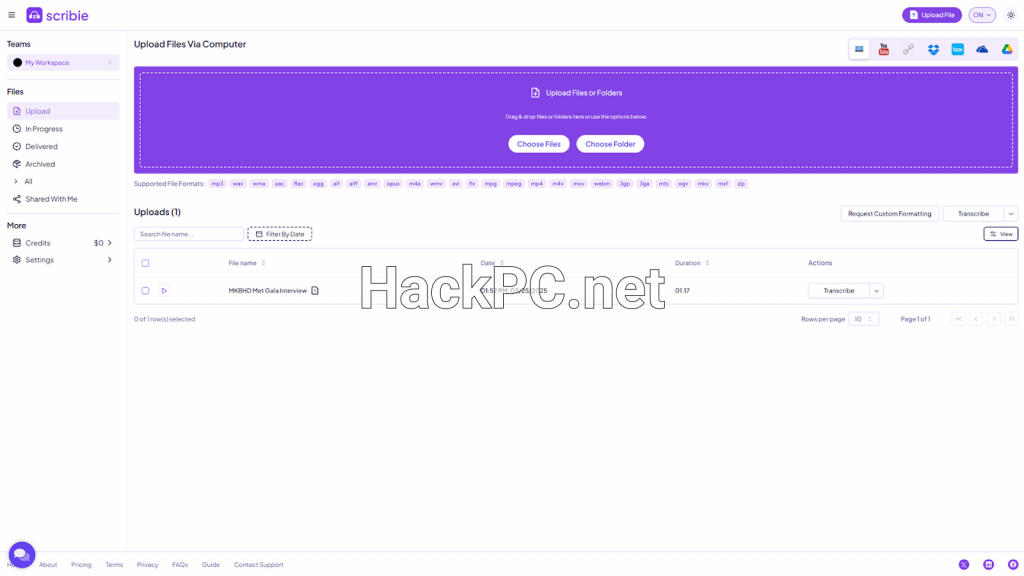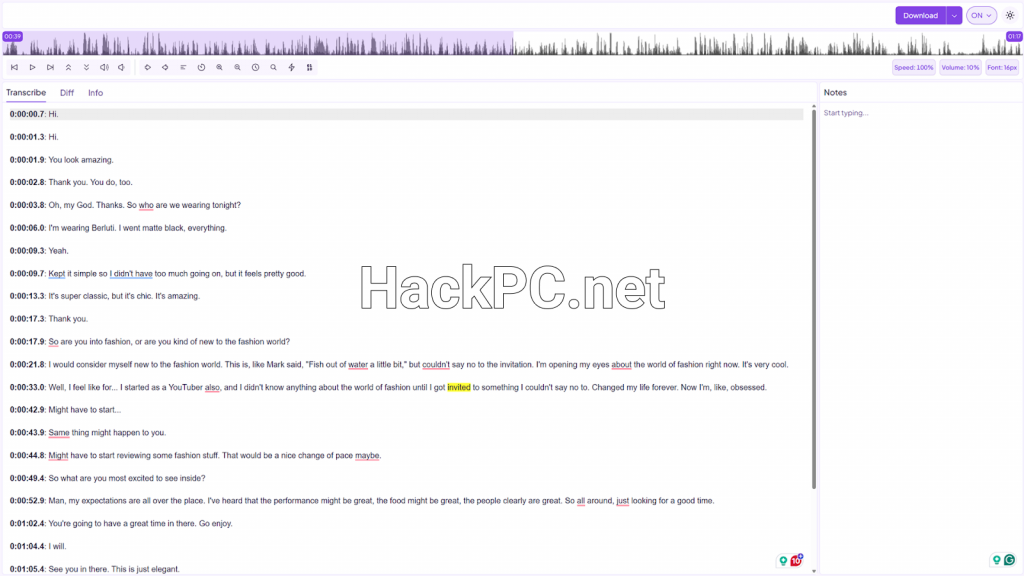
Every business conversation contains gold—customer insights, compliance evidence, training opportunities—but most of it vanishes the moment the call ends. Professional transcription services transform these fleeting audio interactions into searchable, analyzable assets that drive smarter business decisions. Mastering the right transcription workflow can mean the difference between drowning in unprocessed recordings and building a powerful knowledge base from every customer interaction.
Understanding Scribie’s Business Transcription Ecosystem
Scribie represents more than just another audio-to-text conversion service—it’s a comprehensive solution designed specifically for enterprise-grade call processing and business communication management. With over 50,000 certified transcribers and a proven four-step quality assurance process, this platform delivers the accuracy and reliability that modern businesses demand for their critical audio content.
Essential Features for Business Call Processing
The platform’s architecture addresses the unique challenges of business audio transcription through several key components:
Human-Verified Accuracy System: Unlike purely automated transcription tools, Scribie combines artificial intelligence with human expertise to achieve 99% accuracy consistently. This hybrid approach ensures that industry-specific terminology, accented speech, and complex business discussions are captured correctly.
Flexible Turnaround Options: Business operations run on different timelines. The service offers multiple delivery speeds—from rush orders completed within hours to standard seven-day turnaround times with 20% cost savings. This flexibility allows companies to balance urgency with budget considerations effectively.
Enterprise Security Framework: All transcribers operate under strict NDAs, with access restricted on a need-to-know basis. This security architecture makes the platform suitable for sensitive business communications, legal proceedings, and confidential customer interactions.
Setting Up Your Business Transcription Workflow
1. Initial Account Configuration
Begin by establishing your business account with appropriate team access controls. The platform’s Account Credits system enables centralized billing while allowing multiple team members to submit transcription requests independently.
Key Setup Steps:
- Configure your primary business account
- Add team members with appropriate permissions
- Establish default transcription preferences
- Set up API credentials for system integration
2. Implementing the REST API for Automated Processing
For organizations processing high volumes of calls, Scribie’s REST API provides programmable access to transcription services. This backend integration capability transforms manual transcription workflows into automated business processes.
The API supports various configuration options including speaker tracking, verbatim transcription levels, and custom formatting templates—all essential for different business use cases from sales calls to compliance recordings.
3. Optimizing Audio Quality for Better Results
Superior transcription accuracy begins with high-quality source material. When implementing call recording systems for transcription:
Technical Requirements:
- Maintain consistent audio levels throughout recordings
- Use professional-grade recording equipment when possible
- Minimize background noise and echo in recording environments
- Ensure clear speaker separation in multi-party calls
Business process outsourcing companies particularly benefit from these optimizations, as clearer audio reduces processing time and improves first-pass accuracy rates.

Advanced Techniques for Call Center Operations
Processing High-Volume Customer Service Calls
Call centers generate thousands of hours of audio daily, requiring efficient transcription management strategies. Scribie’s platform handles this scale through intelligent file segmentation—breaking longer recordings into 6-10 minute segments for parallel processing by multiple transcribers.
Volume Processing Best Practices:
- Batch similar call types together for consistent formatting
- Use speaker identification features for agent-customer separation
- Implement time-coding for quality assurance reviews
- Create custom templates for recurring call structures
Integration with Business Intelligence Systems
Transcribed call data becomes exponentially more valuable when integrated with analytics platforms. The service provides multiple export formats including plain text, Microsoft Word documents, and structured JSON data suitable for business intelligence tools.
Companies using platforms like Amolto Call Recorder benefit from direct integration, streamlining the entire recording-to-transcript pipeline without manual intervention.
Compliance and Quality Assurance Applications
Financial services, healthcare, and legal industries require meticulous documentation of client interactions. Scribie’s strict verbatim transcription option captures every utterance, pause, and verbal acknowledgment—critical for regulatory compliance and dispute resolution.
Compliance Features:
- Timestamp documentation for audit trails
- Speaker attribution for accountability
- Verbatim capture including non-verbal sounds
- Secure storage with controlled access logs
Maximizing ROI Through Strategic Implementation
Cost Optimization Strategies
Understanding the pricing structure enables businesses to optimize transcription costs without sacrificing quality:
Smart Budgeting Approaches:
- Reserve rush orders for genuinely urgent needs
- Utilize standard turnaround times for routine documentation
- Leverage bulk order discounts for large projects
- Consider automated transcripts for initial review, followed by human verification for critical content
The platform’s transparent pricing starts at $0.80 per audio minute for standard service, with discounts available for high-volume enterprise agreements.
Team Collaboration and Workflow Management
Effective transcription management extends beyond individual file processing. The browser-based editor enables collaborative review and correction, ensuring final transcripts meet organizational standards.
Collaborative Features:
- Real-time progress tracking for pending transcriptions
- Multi-user access to completed transcripts
- Comment and annotation capabilities
- Version control for edited documents
Industry-Specific Applications
Legal and Court Reporting
Court reporters and legal professionals utilize the platform’s specialized formatting options for deposition transcripts and courtroom proceedings. The service maintains chain-of-custody documentation and provides court-ready formatting that meets jurisdictional requirements.
Market Research and Focus Groups
Marketing teams conducting consumer research benefit from accurate transcription of focus group discussions and customer interviews. The platform’s ability to handle multiple speakers and cross-talk situations proves invaluable for capturing authentic consumer feedback.
Corporate Communications and Training
Human resources departments use transcription services for training video captions, internal communication documentation, and meeting minutes. This creates searchable archives of corporate knowledge, improving information accessibility across the organization.
Measuring Success and Continuous Improvement
Key Performance Indicators
Track these metrics to evaluate your transcription workflow effectiveness:
Essential Metrics:
- Average turnaround time per file type
- Error rate and correction frequency
- Cost per minute of transcribed audio
- User satisfaction scores from internal stakeholders
- Time saved versus manual transcription
Quality Assurance Protocols
Implement regular quality checks to ensure transcription accuracy meets business requirements:
- Sample Review Process: Randomly audit 5-10% of completed transcripts
- Feedback Loop: Report recurring issues for process improvement
- Template Refinement: Continuously optimize custom formatting templates
- Training Documentation: Create internal guides for team members

Future-Proofing Your Transcription Strategy
As artificial intelligence continues evolving, the combination of automated processing and human verification remains the gold standard for business transcription. Scribie’s migration to scribie.ai demonstrates their commitment to incorporating cutting-edge technology while maintaining the human expertise that ensures accuracy.
Emerging Trends in Business Transcription
Technology Developments:
- Real-time transcription capabilities for live calls
- Enhanced speaker diarization algorithms
- Multi-language support expansion
- Integration with unified communications platforms
Organizations preparing for these advancements should establish flexible transcription workflows capable of adapting to new technologies while maintaining current operational requirements.
Conclusion: Transforming Voice Data into Business Intelligence
Effective call transcription transforms ephemeral voice communications into permanent, searchable business assets. By implementing Scribie’s comprehensive transcription ecosystem—from API integration to collaborative review tools—organizations unlock the full value of their audio content.
Success requires more than simply uploading files; it demands strategic implementation, continuous optimization, and alignment with broader business objectives. Whether processing customer service interactions, documenting legal proceedings, or capturing corporate communications, mastering these transcription techniques provides the foundation for data-driven decision making and operational excellence.
The investment in professional transcription services pays dividends through improved compliance, enhanced customer insights, and streamlined business processes. As voice interactions continue proliferating across digital channels, organizations with robust transcription capabilities maintain competitive advantages in understanding and leveraging their communication data.
Start small with pilot projects, measure results carefully, and scale successful approaches across your organization. With proper implementation, business transcription becomes not just a documentation tool, but a strategic asset driving continuous improvement and innovation.



Comments (0)